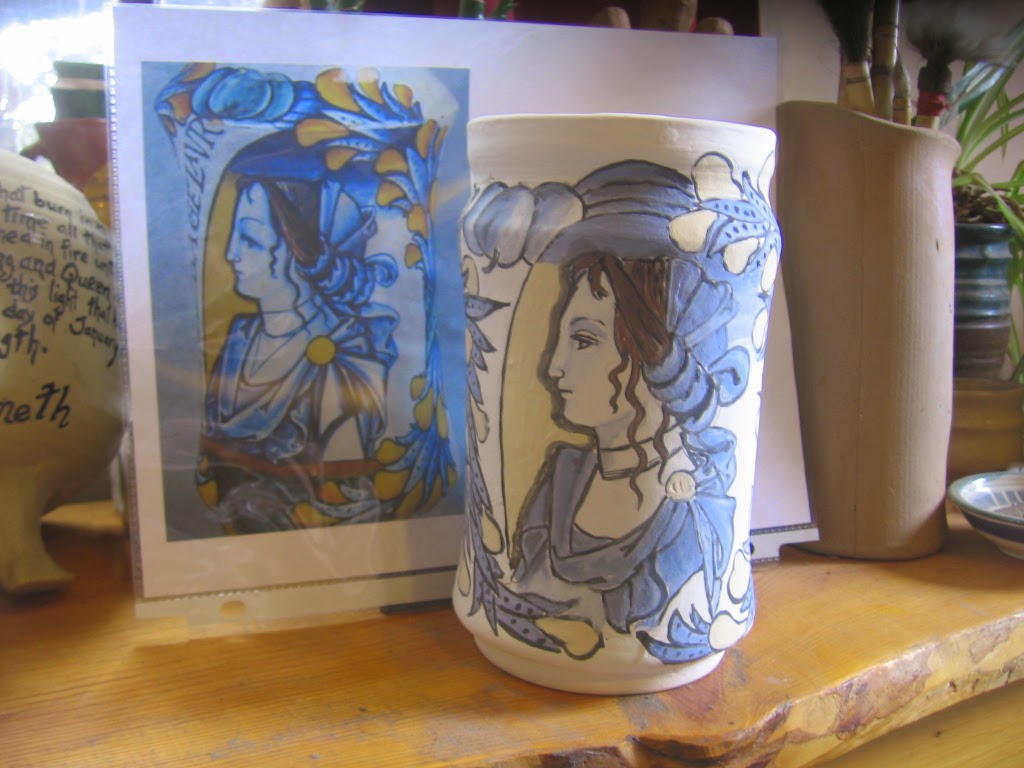Used throughout the Ancient Roman home for light, oil lamps were plentiful, with many extant pieces and their molds available in museums, and photos online and in books. So naturally, I had to make them too.
I was asked how I make my Roman oil lamps. Written answers are not as easy to follow, so these photos taken in progress may be a better explanation of the process.
Most of the examples I have seen photos of are oil lamps that were made from molds. But of course, there had to be a handmade original oil lamp from which the mold was made. This process shows how I made mine, they are similar to how the Ancient ones were constructed I would say as an educated guess. I plan to make a mold of one of these, but first I want to make a number of lamp shapes to choose from.

Step #1 the basic shape. Thrown on the wheel. Notice how the top is concave. An awfully lot of extant oil lamp tops are concave, many more deep than this. I think many from History were thrown because the bottom section of the lamps show a strong, smooth curve. This would be easily made by an experienced thrower. But making the shape from a pinch or coil pot would work too.
Roman oil Lamp shape, the first
Using the same clay, I rolled out a small slab in a rough, trapezoid shape. The clay is about 1/4" thick, which is plenty thick enough.
Now the pot has dried to leather hard, although I have always favored the British term “cheese hard”. The slab was roughly pinched into a cone shape for the spout. I measured it against the body of the pot, adjusted the shape a little so it would fit, drew around the "spout" onto the pot, cut an opening, then slipped and scored both the spout and the pot before sticking them together .
The spout and body are pushed together. It looks awful now, but it will improve, I promise.
The end of the spout is closed because I will make an opening hole for the wick in the top of the spout rather than from the tip like a teapot spout.
The finishing work has started. Smoothing, shaving, a stamp added, carving, the top hole opened for filling of the oil; and then the spout hole for the wick. Often the top fill holes are seen off to the side and not exactly in the center, although sometimes they are, and the mouth of the lion stamp was too perfect to resist for this fill hole. The clay needs to dry more before the finishing touches.
Dry enough that I could add a pulled handle, more finishing, carving on the spout, and clean up of some of the decorative lines. It still will need to be drier before being fired in the kiln.
Roman Oil Lamp the Second
Not a great deal of difference with this Oil Lamp. The primary change is the shape of the spout, which really isn't all that different either.
Same shape for the body. The spout is shorter, more triangular, and with a flat top. The hole is measured, cut and slipped and scored like the first example.
The base of the spout is pressed over the hole and they are smoothed & firmly attached. The top of the spout will be slipped and scored on the edges and also smoothed and pressed so it becomes one piece.
This is an awkward stage. Bleah. Now to let it harden enough to work some improvements.
Smoothed out and the “discus is decorated in a radial design.
Handle attached, spout carved. One of my favorite aspects of these lamps is how often the spouts are carved with various curly ques.
5 ready for the kiln. I don't plan to glaze these, I haven't seen that done. I will leave some plain clay, apply some red slip or terra sigillata to others, as I have seen examples of all those used.
Refrences: http://www.metmuseum.org/collection/the-collection-online/search/253480
Roman Britain by John Ward
The Real thing, Roman Oil Lamp from the 1st. Century CE



























